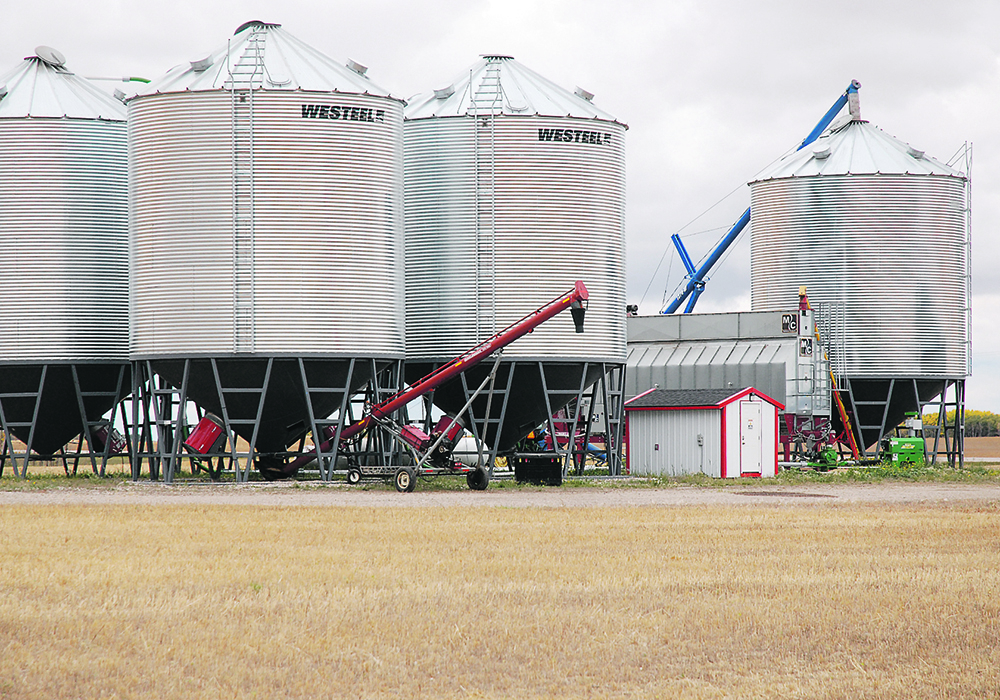Understanding the process can include learning technical terms such as static pressure and equilibrium moisture content
Natural air drying of grain is one of those things that is both complicated and simple.
On the simple side, drying grain in a bin is similar to drying laundry on a line.
“Going back to old days, we used to hang clothes out on the clothes line. As long as the air is drier than the clothes, moisture evaporates out of the clothes and the wind takes it (the moisture) away,” said Ken Hellevang, a professor of agricultural and biosystems engineering at North Dakota State University, who has spent much of the last four decades studying grain drying and storage. “Essentially, that’s what we’re doing with natural air drying (of grain)…. What we’re doing is moving air through the grain (with a fan) to remove the moisture.”
Read Also

Growing garlic by the thousands in Manitoba
Grower holds a planting party day every fall as a crowd gathers to help put 28,000 plants, and sometimes more, into theground
The basic principles of natural air drying of grain are easy to understand, but the processes within a bin are complex.
As an example of the complexity, the Saskatchewan ministry of agriculture has a 12-page fact sheet on natural air drying. The document includes technical terms such as static pressure and equilibrium moisture content to explain the nuances of natural air drying of grain.
The fact sheet also has detailed graphs on the airflow resistance of flax compared to the airflow resistance of lentils.
Hellevang said grain drying is comparable to soil fertility. Scientists fully understand the basics — that the soil must contain sufficient amount of phosphorus, nitrogen and potassium so a crop can reach its yield potential.
However, the biological processes within the soil, where bacteria and fungi make the nutrients available to the plant, are highly complicated and a bit of a mystery.
The terminology of natural air grain drying can be confusing, but the basic principle is straightforward: warm ambient air, when forced through stored grain, will absorb moisture as it moves though the grain mass.
Factors such as airflow, fan power, ambient air temperature, relative humidity of the outside air and the temperature of the grain will all affect the rate of drying.
Another key principle is that natural air drying and aeration of grain are not the same thing.
“For aeration, in the true sense of the word, all we’re trying to accomplish is to cool the grain mass down or to make the temperature of that grain uniform, so we’re using relatively low airflow rates. The common recommendation is somewhere between one-tenth and two-tenths of a cubic foot per minute per bushel,” John Ippolito, a regional crop specialist with Saskatchewan Agriculture, said in 2017.
“For natural air grain drying to be effective, we’re looking for airflow rates in the range of one to two cubic feet per bushel per minute, so nearly 10 times the air flow that we would expect in aeration.”
That difference is critical to understand, especially since grain bins are getting larger and larger.
Some bins are now 12.8 metres in diameter with side panels that are 11 metres high.
Such bins have a capacity of 500 to 1,000 tonnes of wheat.
It’s possible to aerate a bin that size, but nearly impossible to dry all the grain with a fan, Hellevang said.
“Many times, people forget how much moisture we have to remove from a bin of grain,” he said.
“We’re taking out hundreds if not thousands of gallons of water out of a bin…. It takes a lot of airflow to do the natural air drying in a bin.”
In the case of a larger bin, with a diameter of 12.8 meters and 11 metre side walls, fans don’t have sufficient power to push air through the grain.
“To move enough airflow through that greater depth (for drying), we might be looking at a 150 horsepower (fan) to try and dry in that bin,” Hellevang said, adding such a powerful fan isn’t feasible or economical.
When it comes to myths and misconceptions about natural air grain drying, some growers may have heard that running fans only at night will dry the grain more rapidly.
“One of things that has caused some confusion in the last few years … is that we’re better off to run the fan at night rather than at the daytime,” Hellevang said.
“That’s totally false. From a commonsense standpoint, we know that warm air is better at drying something than cold air…. The same thing applies in a grain bin…. The warmer the air, the drier it is, the more moisture that air can pick up and the faster (grain) dries.”
That’s why it’s easier to dry grain in September than in October because the air temperature is warmer and relative humidity is often lower.
Having studied grain drying and storage for nearly 40 years, Hellevang has learned a few lessons along the way.
One is that grain drying is variable. Natural air drying of corn in Missouri is different from drying wheat in Montana.
“One of the things I keep telling everyone is you can’t take something that works in Illinois and Iowa … and directly transfer it to North Dakota or Canada. Our climate is different and the crops are different.”


















